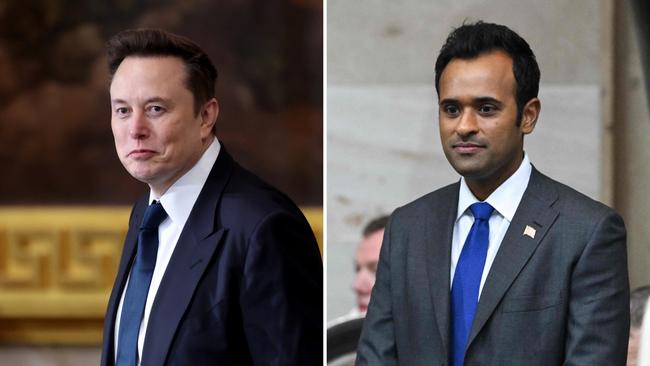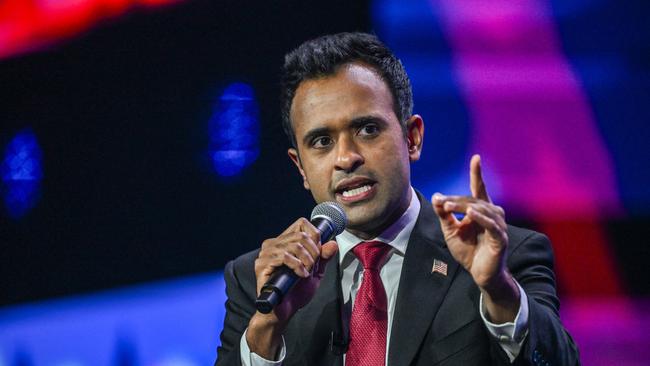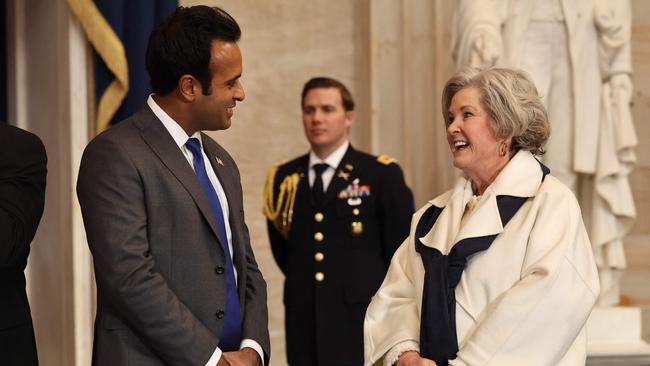Inside the Elon Musk, Vivek Ramaswamy DOGE divorce
Biotech-company founder departs DOGE after his goal of trimming regulations was overtaken by Musk’s priority of cutting spending.

The Department of Government Efficiency was originally envisioned as a joint Elon Musk — Vivek Ramaswamy mission outside the federal government. Now it is all Elon — and he is inside.
Musk’s vision for DOGE — along with his relentless, 24/7 online promotion of its goals — has quickly won out in President Trump’s first days in office, as Ramaswamy has decamped for his home state of Ohio to announce next week a planned bid for governor in 2026 and the DOGE operation has been installed inside the new president’s administration. Musk has been working this week from a West Wing office, according to a person familiar with the situation.
Tensions and philosophical differences between the two billionaires, who first met in 2023 when Ramaswamy was still challenging Trump for the Republican presidential nomination, didn’t take long to emerge.

People familiar with the situation said Trump’s inner circle of aides had become annoyed with Ramaswamy’s outspokenness on virtually any topic, a tendency that had also aggravated the Tesla and SpaceX CEO.
“There were always going to be tensions between two CEOs who have built successful companies,” said a person familiar with DOGE. “Everyone saw the writing on the wall.” A frequent poster on Musk’s X platform, Ramaswamy also angered some Trump supporters and aides in late December when he let loose with a long message as part of a debate over H-1B visas, suggesting some U.S. technology companies hire foreign workers in part because U.S. culture has “venerated mediocrity over excellence for way too long.” The split was also predicated in part by DOGE’s increasing attention on achieving spending cuts, which Musk has championed, and less of a focus on cutting regulations and bureaucracy, which had been helmed by Ramaswamy, according to another person familiar with the discussions.
There are “no hard feelings” between Musk and Ramaswamy, the person said, but “as the mandate narrowed and shifted, Vivek’s ability to add on to that changed and it was his decision to step away.” During Trump’s transition, there had been internal speculation on whether DOGE would be set up within the government, potentially as a federal advisory committee, or in the form of an outside think tank or an advocacy group set up as a non-profit. Ramaswamy had long argued that the effort needed to exist outside the government.
“We concluded that if this job were ever going to be done, it had to be done by outsiders and in many ways from the outside,” he said in a November Wall Street Journal interview. “Politicians for a long time have talked about downsizing the federal government. Doing it in the standard way wasn’t going to work.” But the president’s first-day executive order made clear that DOGE will function within the executive branch, renaming the United States Digital Service, which was established by the Obama administration following initial failures of the Obamacare website. The agency was charged with boosting information technology services for federal agencies.
The new entity will be called the United States DOGE Service, with an administrator who will report to White House chief of staff Susie Wiles. The executive order requires individual federal agencies to create DOGE teams with a team leader, an engineer, a human-resources specialist and an lawyer. It hasn’t been made clear if those employees would be new or if they would be compensated. Musk initially said on X “compensation is zero.”

DOGE, which has largely operated in secret helped by encrypted messages on Signal exchanged by staff, has quickly faced lawsuits. One filed Monday by the advocacy groups Public Citizen and State Democracy Defenders Fund as well as a labour union, the American Federation of Government Employees, argued that DOGE was failing to comply with the Federal Advisory Committee Act because its meetings have been held in secret and records haven’t been available to the public.
One aspect of Trump’s executive order — in a nod to a key Musk priority — urges agencies to implement the DOGE agenda “by modernising federal technology and software to maximise governmental efficiency and productivity.” Musk’s effort, which will give him considerable additional insight into a government he does significant business with, is expected to be completed by July 4, 2026.
One of the people said the executive order “surprised a lot of people” because it brought DOGE, which was originally envisioned as an outside entity, into the executive branch. The executive order was developed only in the past two weeks, the person said.
“Elon was for it, Vivek was against it. I don’t think it spoke to the original mission, the vision for DOGE, as articulated by Trump two months ago,” the person said.
One of the people familiar with DOGE said there had initially been a “rough understanding” that Musk and Ramaswamy would be “equal partners” in the project, although there was an acceptance that Musk would be a “senior partner” because of his global stature and relationship with Trump.
The thinking had been that Ramaswamy would focus on deregulation and constitutional arguments for reducing government, both topics he had spoken about for years in his writings and on the campaign trail. Musk would focus on the technology piece of the mission and the use of artificial intelligence to reduce the federal workforce.
Once the decision was made that DOGE wouldn’t be an outside entity, Ramaswamy knew it would conflict with his goal of running for governor in Ohio because of the disclosures and other requirements associated with being part of the federal government.
Next week, Ramaswamy is expected to announce a campaign to succeed Republican Gov. Mike DeWine, who is term-limited after he completes his second term. DeWine, a more traditional Republican, bypassed Ramaswamy last week to fill the Senate seat vacated by Vice President JD Vance.
“He could not credibly run as an employee of the federal government,” the person said.
The Wall Street Journal
